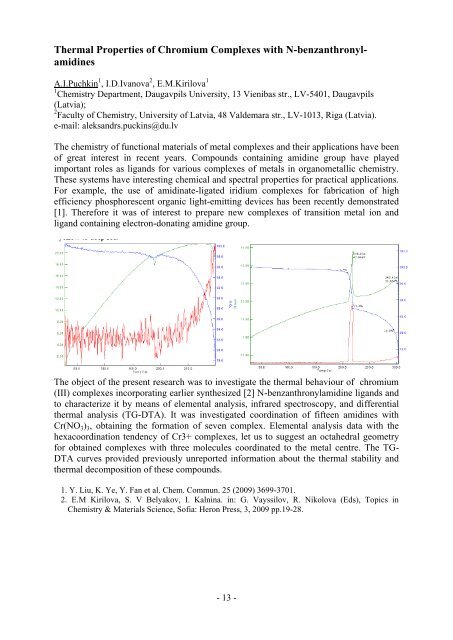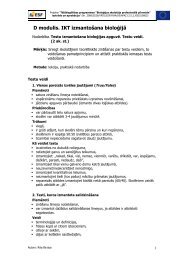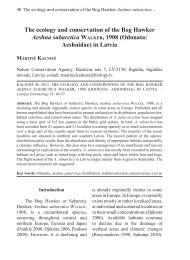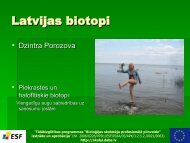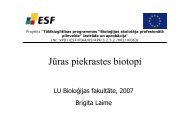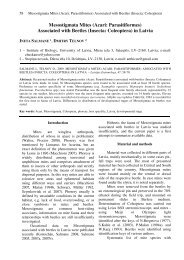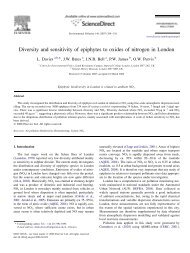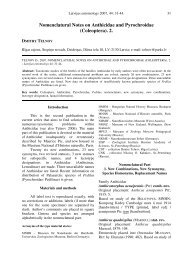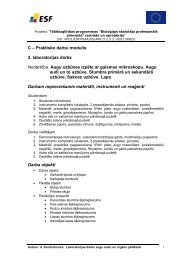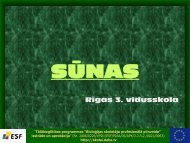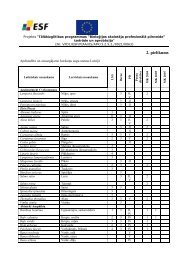Dissolved organic matter in water of Daugava river
Dissolved organic matter in water of Daugava river
Dissolved organic matter in water of Daugava river
Create successful ePaper yourself
Turn your PDF publications into a flip-book with our unique Google optimized e-Paper software.
Thermal Properties <strong>of</strong> Chromium Complexes with N-benzanthronylamid<strong>in</strong>esA.I.Puchk<strong>in</strong> 1 , I.D.Ivanova 2 , E.M.Kirilova 11 Chemistry Department, Daugavpils University, 13 Vienibas str., LV-5401, Daugavpils(Latvia);2 Faculty <strong>of</strong> Chemistry, University <strong>of</strong> Latvia, 48 Valdemara str., LV-1013, Riga (Latvia).e-mail: aleksandrs.puck<strong>in</strong>s@du.lvThe chemistry <strong>of</strong> functional materials <strong>of</strong> metal complexes and their applications have been<strong>of</strong> great <strong>in</strong>terest <strong>in</strong> recent years. Compounds conta<strong>in</strong><strong>in</strong>g amid<strong>in</strong>e group have playedimportant roles as ligands for various complexes <strong>of</strong> metals <strong>in</strong> organometallic chemistry.These systems have <strong>in</strong>terest<strong>in</strong>g chemical and spectral properties for practical applications.For example, the use <strong>of</strong> amid<strong>in</strong>ate-ligated iridium complexes for fabrication <strong>of</strong> highefficiency phosphorescent <strong>organic</strong> light-emitt<strong>in</strong>g devices has been recently demonstrated[1]. Therefore it was <strong>of</strong> <strong>in</strong>terest to prepare new complexes <strong>of</strong> transition metal ion andligand conta<strong>in</strong><strong>in</strong>g electron-donat<strong>in</strong>g amid<strong>in</strong>e group.The object <strong>of</strong> the present research was to <strong>in</strong>vestigate the thermal behaviour <strong>of</strong> chromium(III) complexes <strong>in</strong>corporat<strong>in</strong>g earlier synthesized [2] N-benzanthronylamid<strong>in</strong>e ligands andto characterize it by means <strong>of</strong> elemental analysis, <strong>in</strong>frared spectroscopy, and differentialthermal analysis (TG-DTA). It was <strong>in</strong>vestigated coord<strong>in</strong>ation <strong>of</strong> fifteen amid<strong>in</strong>es withCr(NO 3 ) 3 , obta<strong>in</strong><strong>in</strong>g the formation <strong>of</strong> seven complex. Elemental analysis data with thehexacoord<strong>in</strong>ation tendency <strong>of</strong> Cr3+ complexes, let us to suggest an octahedral geometryfor obta<strong>in</strong>ed complexes with three molecules coord<strong>in</strong>ated to the metal centre. The TG-DTA curves provided previously unreported <strong>in</strong>formation about the thermal stability andthermal decomposition <strong>of</strong> these compounds.1. Y. Liu, K. Ye, Y. Fan et al. Chem. Commun. 25 (2009) 3699-3701.2. E.M Kirilova, S. V Belyakov, I. Kaln<strong>in</strong>a. <strong>in</strong>: G. Vayssilov, R. Nikolova (Eds), Topics <strong>in</strong>Chemistry & Materials Science, S<strong>of</strong>ia: Heron Press, 3, 2009 pp.19-28.- 13 -


